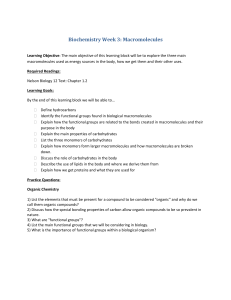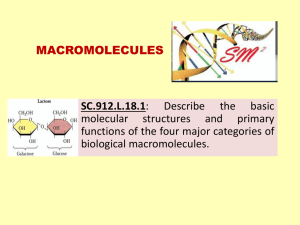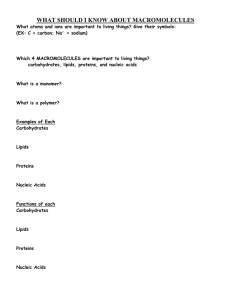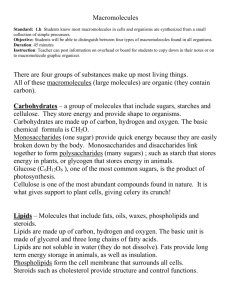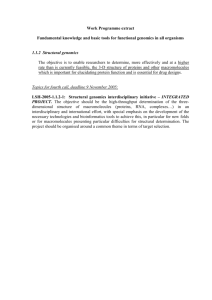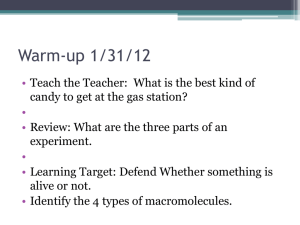LessonPlan3and4 - SMC-MAT
advertisement
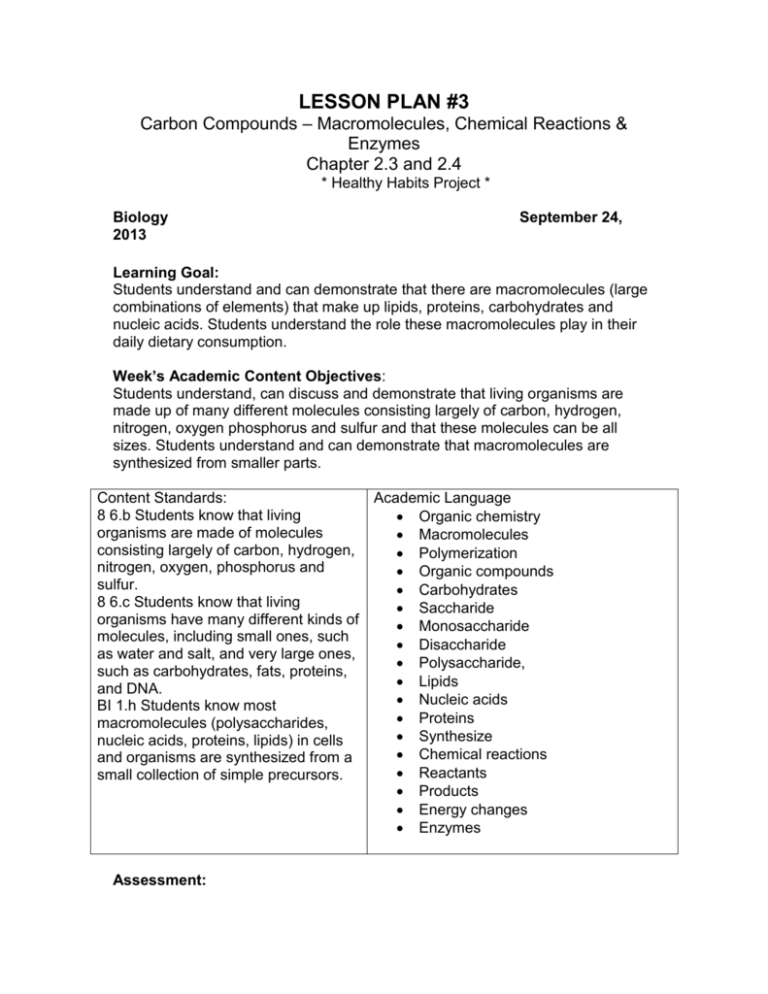
LESSON PLAN #3 Carbon Compounds – Macromolecules, Chemical Reactions & Enzymes Chapter 2.3 and 2.4 * Healthy Habits Project * Biology 2013 September 24, Learning Goal: Students understand and can demonstrate that there are macromolecules (large combinations of elements) that make up lipids, proteins, carbohydrates and nucleic acids. Students understand the role these macromolecules play in their daily dietary consumption. Week’s Academic Content Objectives: Students understand, can discuss and demonstrate that living organisms are made up of many different molecules consisting largely of carbon, hydrogen, nitrogen, oxygen phosphorus and sulfur and that these molecules can be all sizes. Students understand and can demonstrate that macromolecules are synthesized from smaller parts. Content Standards: Academic Language 8 6.b Students know that living Organic chemistry organisms are made of molecules Macromolecules consisting largely of carbon, hydrogen, Polymerization nitrogen, oxygen, phosphorus and Organic compounds sulfur. Carbohydrates 8 6.c Students know that living Saccharide organisms have many different kinds of Monosaccharide molecules, including small ones, such Disaccharide as water and salt, and very large ones, Polysaccharide, such as carbohydrates, fats, proteins, Lipids and DNA. Nucleic acids BI 1.h Students know most Proteins macromolecules (polysaccharides, Synthesize nucleic acids, proteins, lipids) in cells Chemical reactions and organisms are synthesized from a Reactants small collection of simple precursors. Products Energy changes Enzymes Assessment: Informal: The Journal Write in Students Science Notebook is an opportunity to check for understanding of the textbook reading from the previous days lesson. Reviewing, as a class the Macromolecule graphic organizer, is an informal assessment of student understanding. White Board responses during the PowerPoint provides immediate assessment of understanding of the textbook reading and PowerPoint Lecture Presentation. Formal: On Friday, Students will be responsible for having completed and turned in, for assessment, their Cornell Notes, the Crossword Puzzle and the Organic Molecules of Life Chart graphic organizer (in SNB) and Questions. Instruction (engaging students in the construction of meaning): How will you begin the lesson? Journal Write - Teacher Talking Points min In their Science Notebooks, Students will respond to the following prompt: 10 What is the relationship between monomers and polymers? How does this relate to macromolecules? Student’s entries will be signed off (initialed directly in their Science Journal) by the Teacher to assure completion. Following Student’s allotted time to complete the Journal Entry, the Teacher will randomly select Students to read their entry. Teacher, typically, will select 4 students (2 female and 2 male) to read their entries. Teacher Talking Points: Monomers make larger molecules called polymers. Train as an example (monomers – cars, polymers – entire train.). Body of Lesson 30 min Lecture Day: Teacher will present a lecture, using a PowerPoint, to review and reinforce the reading from the previous days lesson. The PowerPoint will be visual support of the previous days reading. White Board response will be used as a check for understanding (PowerPoint slides attached). During the Lecture, Students will be treated to a healthy breakfast/lunch. This will be done by the Teacher to model healthy eating. Following the PowerPoint, the class will review the Organic Macromolecules graphic organizer assigned on Monday. As a class and using Equity Sticks, the chart portion of the organizer will be discussed and completed. Students will be required to complete the questions on the back of the Chart on their own. Reminder: Students must use complete sentences in answering questions on the back of their Macromolecule grahic organizer. During the remaining of the time in the class period, Students will be allowed to work, individually, on the Cornell Notes/Vocab, the Macromolecules Chart graphic organizer and the Crossword Puzzle. Encourage Students to complete the Cornell Notes prior to doing the Crossword Puzzle. Inform them that the Crossword will be much easier with an understanding of the Academic Language. Monitoring for Understanding/ Accommodations While Students are writing in their Journal, Teacher will circulate in the room to assure Students understand the Daily Question, are completing the Journal Write in their Science Notebook (SNB) and understand previous days textbook reading. Signing off on Student’s SNB entry (teacher’s initials in the Science Notebook) assures Students consider and complete the entry. The PowerPoint provides a review and reinforcement of the main concepts of the previous days’ textbook reading. Additionally, the visual depiction of the content will provide access for visual learners. White Board response during the PowerPoint will allow the Teacher to assess Student understanding of the content. Additionally, it provides an opportunity to reteach important concepts and correct misconceptions. Review of the Organic Molecules of Life Chart graphic organizer is another means of checking for understanding and will allow access to the information for those Students who need assistance. Placing this graphic organizer in the Science Notebook allows future access to the information by Students as the Teacher builds on the concepts from this lesson in future lessons. Closure 5 min Teacher will ask if there are any questions on the Organic Macromolecules graphic organizer. Remind Students that there is an Extra Credit opportunity. Extending the Lesson (HW, Think about …, Ask …): 2 min Remind Students they need to complete their work as homework, if not completed in class. Quick discussion of time management is appropriate, if time permits. Reminder EXTRA CREDIT: Students are provided an opportunity to participate in extra credit points. This week, Students can read 2.4 of the textbook (Chemical Reactions and Enzymes) and complete “Enzymes in Action” (attached). This extra credit is worth 20 points. This extra credit opportunity should also be posted in the classroom (in the Extra Credit location, near the computer lab). Reflection/Next Steps (What worked? What did not work? What will you do tomorrow? Why?): Whiteboard Responses LESSON PLAN #4 Carbon Compounds – Macromolecules, Chemical Reactions & Enzymes Chapter 2.3 and 2.4 * Healthy Habits Project * Biology September 25, 2013 Learning Goal: Students understand and demonstrate that there are macromolecules (large combinations of elements) that make up lipids, proteins, carbohydrates and nucleic acids. Students understand the role these macromolecules play in their dietary consumption. Week’s Academic Content Objective: Students understand, can discuss and demonstrate that living organisms are made up of many different molecules consisting largely of carbon, hydrogen, nitrogen, oxygen phosphorus and sulfur and that these molecules can be all sizes. Students understand and can demonstrate that macromolecules are synthesized from smaller parts. Content Standards: Academic Language 8 6.b Students know that living Organic chemistry organisms are made of molecules Macromolecules consisting largely of carbon, hydrogen, Polymerization nitrogen, oxygen, phosphorus and Organic compounds sulfur. Carbohydrates 8 6.c Students know that living Saccharide organisms have many different kinds of Monosaccharide molecules, including small ones, such Disaccharide as water and salt, and very large ones, Polysaccharide, such as carbohydrates, fats, proteins, Lipids and DNA. Nucleic acids BI 1.h Students know most Proteins macromolecules (polysaccharides, Synthesize nucleic acids, proteins, lipids) in cells Chemical reactions and organisms are synthesized from a Reactants small collection of simple precursors. Products Energy changes Enzymes Assessment: Informal: Questioning leading into the lab and during review of laboratory procedures allows for a check of Student understanding of content objectives and lab procedures. Formal: Friday, following Day 2 of the lab, Students will turn in their lab report for formal assessment. While Students are conducting the Lab, the Teacher will conduct informal assessment of understanding by observing Student work and questioning while visiting lab stations. Instruction (engaging students in the construction of meaning): How will you begin the lesson? In their Science Notebooks, Students will respond to the following quick prompt: What element must be present in a molecule for that molecule to be considered organic? Answer: Carbon. Assure Students understand the presence of the element carbon in protein, lipids, carbohydrates and nucleic acids. Refer to the textbook to examine structures of the 4 macromolecules and the presence of carbon in each. Prior to beginning the lab, Teacher will discuss the following Healthy Habits connection: The presence of macromolecules in all the foods we eat The importance of monitoring the intake of these macromolecules The connection between macromolecule intake and exercise Body of Lesson 45 min Pre-Lab Set Up – Teacher: TESTING FOR CARBOHYDRATES Set up: label 8 locations on the demonstration lab station with a number 1 through 8. (Do not label the food items. Students, either today or in tomorrow’s lab, will be encourage to guess the food items and include their guess on their lab worksheet.) Fill a 50 ml beaker to approximately the halfway point with the following items: Butter (melted in the microwave) Mash Potato Flakes (2 to 3 scoops and add 3 ML of water) Small Curd Cottage Cheese (2 scoops) Chicken Broth Vegetable Oil Saltine Crackers, finely crushed (2 to 3 scoops and add 3 ML of water) Egg Whites Milk NOTE: Place a beaker with water next to the mash potatoes and crackers with a pipette in each. On the Number Labels, include a note to add the additional water as described above. Place a pipette (marked with a Sharpie at 1 ML and 2 ML) in the butter, chicken broth, vegetable oil, egg whites and milk. Place an ice cream stick in the mash potatoes, cottage chees and crackers. Each lab station (7 stations) will have the following lab equipment set up prior to Students entering the classroom: 2 Test Tube Racks 8 Test Tubes label 1 to 8 (marked with a Sharpie) Test Tube brush for cleaning Extra pipettes (for indicator). NOTE; Students will test for carbohydrates on Wednesday (early release day), and protein and lipids on Thursday. With Students: Give Students a quick overview of the lab (testing for carbohydrates, proteins and lipids). Question for understanding by asking: 1. What are the four macromolecules? 2. What element must be present in order for that macromolecule to be considered organic? 3. How do these macromolecules relate to your daily eating habits? 4. Ask Students if Lab Safety Rules need to be re-addressed. If so, see page 26 of Science Notebook. Remind Students, anyone not abiding by our Lab Safety Rules will be asked to seat at their desk and work on homework rather than participate in the lab. 5. Explain how to use a pipette a. Before submerging, squeeze out the air b. Slowly release and fill pipette to 1 or 2 ML. For 3 ML, obtain 2 ML, then 1 ml (due to efficiency of pipettes). c. Squeeze completely to get all liquid out 6. Provide additional explanation of the indicator (iodine) to be used for carbohydrate testing. Be sure to: Discuss with Student’s that iodine is poisonous and should be handled with care. If you get it on your skin, wash off immediately. It stains clothing so avoid contact. 7. Review with Students techniques for avoiding cross contamination of solutions and specimens: Don’t use pipettes in more than one solution. Never put the pipette into the test tube but rather drip the fluids in from above the rim of the test tube. o A demonstration of this technique will assist in understanding. - Each Student will turn in a lab report Distribute the Lab Worksheet and as a class, read the precursor (Teacher can read or call on Students to read). Discuss the procedures for carbohydrate testing as outlined on the Lab Worksheet. Require Students to circle 2 ML for increased understanding and future reference. Be sure to discuss the Data Table and the recording of their results (a simple yes or no). Confirm with Students recognition of the questions on the back of the Lab Worksheet. Remind Students that upon completion of the lab on Day 2, Students will be required to answer, using complete sentences, the questions. Lab Groups: Students will work in lab groups of 2 to 3 as outlined on the attached list. For time management reasons, Students should all participate in the collection of their specimens (dividing the test tubes up between the lab group). Teacher or Collaborating Teacher should provide guidance during specimen collection. After collecting specimens, Students will return to their lab station. Teacher will bring iodine to the lab station for Student use once all 8 specimens have been collected. Monitoring for Understanding/Accommodations Reading before the lab provides knowledge of the upcoming lab. The warm up questions are to check for understanding. The questioning during review of lab procedures provides for monitoring for understanding. Demonstrating proper lab techniques (pipette usage and specimen collection) provides an informal visual check for understanding. Using the lab as a means to understanding macromolecules visually to connect the reading and discussions with the concept for all types of learners. Groups have been organized to accommodate Students varied achievement levels. Closure 5 min Students will be responsible for cleaning the test tubes and their lab stations. The test tubes should be cleaned thoroughly using dish soap and rinsing placing the test tubes upside down on the test tube rack (for draining of water). The Teacher can visit lab stations and provide soap on the rim of the sink for clean up purposes. The Teacher will circulate in the classroom to assure clean up is proceeding according to Teacher expectations (especially in light of the following class starting immediately). Extending the Lesson (HW, Think about …, Ask …): There will be no extension of the Lesson other than to remind Students that the following day’s lab will include testing for proteins and lipids. Additionally, a reminder about the lab related questions on the back of the lab report and the necessity to complete them using complete sentences. Reflection/Next Steps (What worked? What did not work? What will you do tomorrow? Why?):
